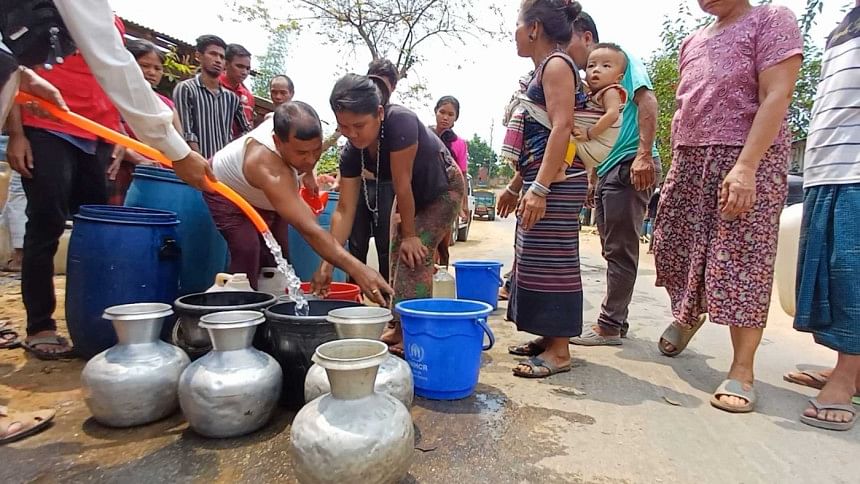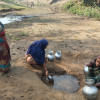Water woes worsen in the hills

Residents of the hilly areas on both sides of Chimbuk-Neelgiri road in Bandarban have been facing a severe water crisis amid the ongoing hot spell.
The waterfalls and small streams in the hills, known as jhiri, have almost dried up. People are being forced to walk considerable distances, taking more than an hour to collect even a bucket of water from the jhiris.

Some families are even compelled to buy water collected from jhiris at Tk 2-5 per litre for their families.
There are more than 500 families from different communities living in 35 villages on both sides of the road, including Korang Para, Krapung Para, Sita Para, Bagan Para, Mrolong Para, and Getsimoni Para, among others.

Bangladesh Red Crescent Society in Bandarban distributed safe water on Wednesday among the residents of Korang Para area, about 42 kilometres from the district headquarters. Men and women formed a long queue there while elaborating on the ordeals they have been going through amid the water crisis.
Visiting Getsimoni Para near Chimbuk-Neelgiri-Thanchi road recently, this correspondent saw a ninth grader entering a 5-6 feet deep hole dug at the end of a jhiri to collect water. At least 75 families collected water from that jhiri in the same way in turns.
Around 210 families live in Korang Para, with most of them belonging to the Mro community.
Since the villages are located near the peak of the hills, the residents have to come down around 1,000 feet to the jhiris and small waterfalls to collect water for household use, said Liyang Kim Bawm of Korang Para.
"Every summer, we go through a severe water crisis. We hardly get enough water for drinking. We are taking baths after 2-3 days with only a litre of water or two," he added.
Locals are resorting to collecting whatever quantity they can manage as there is hardly any water in the jhiris, said Chinghlau Kheyang, another resident of the village.
As there are not many big trees left in the hills, the jhiris and waterfalls are all drying up, they said.
Reng Yok Mro, another trader at Korang Para Bazar, said, "It is getting more and more difficult for the hill residents to live amid the hot spell. The water crisis made the situation worse for us."
Rengwai Mro, a member of local Gyalenga Union Parishad and resident of Korang Para, said, "Women have to go through a lot of trouble to come down around 1,000 feet and collect water from jhiris, often taking around one and a half hours."
Locals said though it rained for a while on Thursday night, it did not change the situation much.
Banting Marma, a journalist who took initiative to distribute water among locals, said he came to know about the sufferings of the villagers while reporting on the water crisis in Chimbuk-Neelgiri area about two years ago.
"Since then, we have been distributing water among villagers for the past two years," he said.
"This year too, two or three of us distributed water among the locals. Later, the district Red Crescent Society and the Public Health Engineering department's office extended support with 100 jars of water (five litres each)," Banting added.
Amal Kanti Das, general secretary of Red Crescent Society's Bandarban unit, said their initiative will continue till monsoon.
Anupam De, executive engineer of the Public Health Engineering department in Bandarban, said, "Aimed at mitigating the water crisis in Bandarban, two projects funded by Asian Development Bank are ongoing in Sadar and Lama upazilas. Also, two more projects have been proposed to the CHT affairs ministry for approval. If the projects are approved and implemented, the crisis will reduce significantly."

 For all latest news, follow The Daily Star's Google News channel.
For all latest news, follow The Daily Star's Google News channel. 










Comments